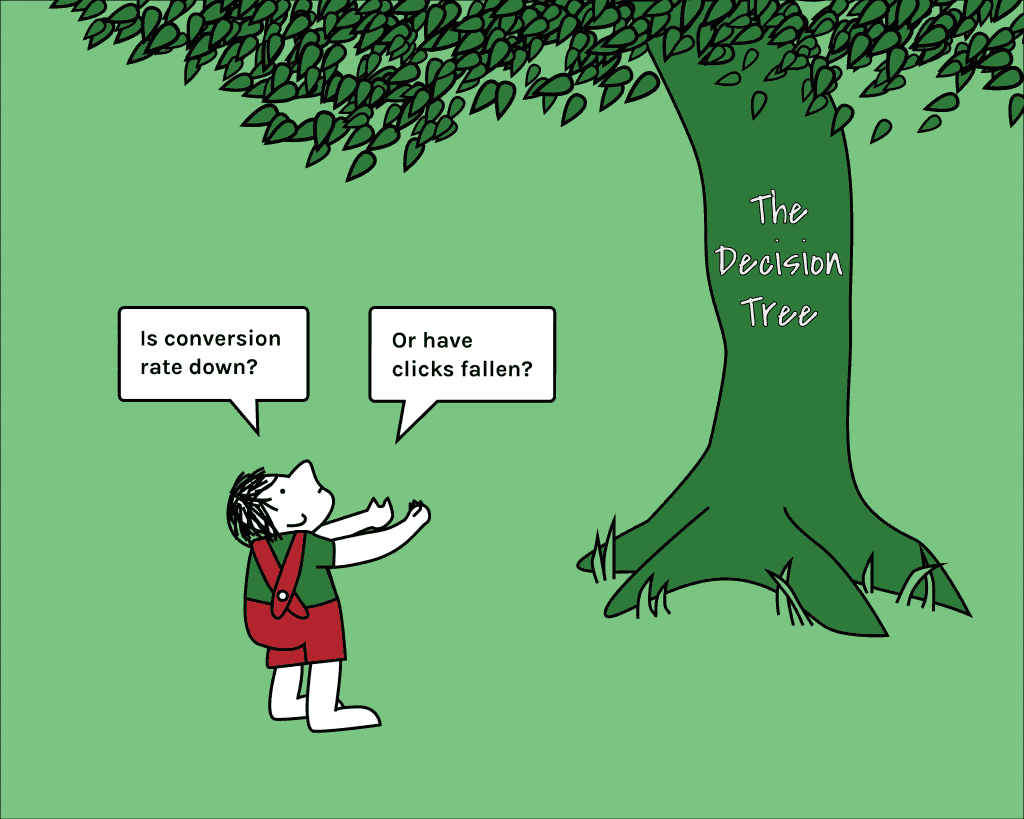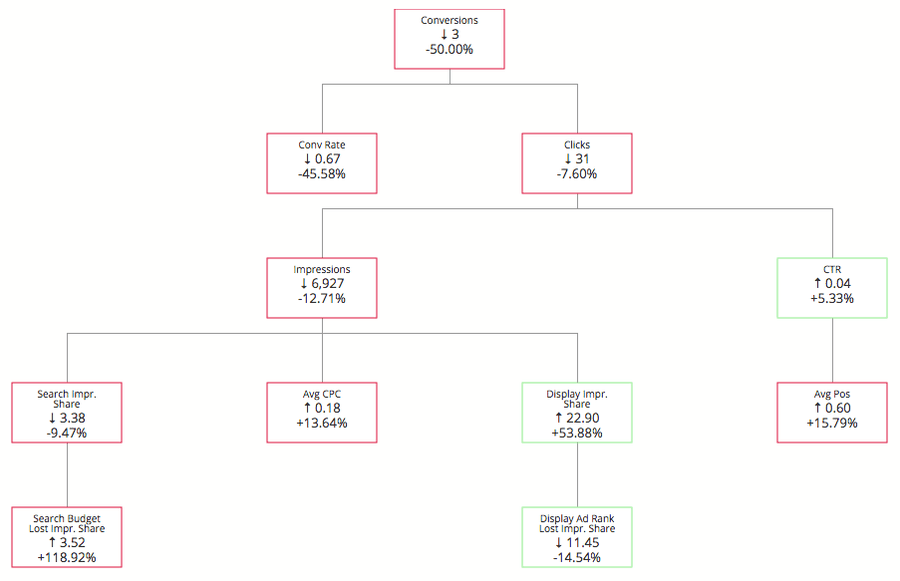Simplify Your Paid Search Accounts With a Decision Tree

The other day I was looking at one of my search accounts that had fallen into an unusual slump. I was checking the normal key metrics—clicks, impressions, CTR, conversion rate—trying to figure out what went wrong. I was stumped.
Maybe my ad copy had gotten stale and we needed to run a new ad copy test. Maybe search trends had changed and we needed to switch out our targeted keywords. Maybe the industry had reached a new level of competition and our account needed to be completely restructured in order to differentiate it from competitors. There were too many factors involved and I didn’t know what to do next.
All of these thoughts rushing through my head pulled me further and further away from deciding what to do next. Then, I remembered the decision tree.
Feeling Stuck on a Search Account? Try a Decision Tree
The SEM software tool Optmyzr uses the decision tree shown below. At Perfect Search, we use a slightly different tree that’s customized to highlight the key metrics for each account. It’s important to note that the exact layout and specifics of the tree isn’t as important as having it organized to show the relationship between each metric in the account. I recommend starting with the Optmyzr version below and then making small changes and additions until you have the perfect version for your needs.
Once I looked back at this decision tree I realized what I really needed to do: simplify my thinking. A search account is incredibly complex. In order to properly optimize it, you need to be able to break it down into two key aspects: 1) where the issue is located, and 2) what optimization will improve the issue.
That’s where the decision tree comes in.
How Do You Use a Decision Tree?
You first put your primary key performance indicator (KPI) at the top of the tree and work down from there. In the above tree’s case, the KPI is conversions. You can then break down the lack of conversions into two options: is the conversion rate down or have clicks fallen?
If clicks are too low, then you continue to move down the tree until you get to the source of the issue. In some cases, you will find several areas that need to be improved. For example, you may first discover that your conversion rate is too low for the account performance to be sustainable. But that doesn’t mean you stop there! Continue to move down the tree because there may be other potential issues.
Sound simple? It’s not always that easy. Finding the source of an under-performing search account is only one half of the journey. You still have to figure out what needs to be changed to improve the account.
How Do You Decide What Optimizations to Make?
Sometimes deciding what optimization to make can be more difficult than finding the areas you need to improve. Again, simplification is key to deciding what to do next. At the most fundamental level, there are really only 5 questions to ask yourself when trying to choose the correct optimization.
- How much money are you spending per day?
- What are your maximum CPC bids?
- What keywords are you targeting?
- What are your landing pages?
- What does your ad copy look like?
Seriously, those 5 questions encompass almost every issue that could be wrong with your paid search account. Still feeling pretty simple? Unfortunately, there’s a bit more intricacy involved.
The complexity comes from all of the variations within each of these optimizations and how they each interact together. If you’re thinking about changing your maximum CPC bids, you have to think about a lot more than just that you’re going to change them. Are you bidding up or down and by how much? Is the bid adjustment happening across the board or only on certain devices or locations? These are all questions that must be addressed when you manage a search account.
Use a Decision Tree, Don’t Get Stumped
Even when you simplify the process as much as possible, managing a successful account is still incredibly complex. Unfortunately, there’s never a simple solution that works 100% of the time. Because of the overwhelming amount of choices presented to you every day when managing paid search accounts, anything that can help you simplify your process is necessary.
Remember that account that stumped me? By using the decision tree, I was able to find a couple of key performance issues in our client’s account and start hitting our KPI benchmarks again.
Once you get more comfortable using the decision tree, you’ll notice that you will start finding issues in your account much faster than before. Remember: the sample decision tree shown above is just a starting point. You’ll get the most value out of a decision tree by customizing it for your personal preferences and your account’s needs.
—
How do you simplify managing your paid search accounts? Are you a fan of decision trees? (Side note: has Shel Silverstein’s The Giving Tree made you cry? Us too.) Let us know your thoughts on decision trees and Giving Trees by tweeting us @Perfect_Search or emailing us at info@perfectsearchmedia.com.

Anthony Lower is an Indiana University alum who really wishes Chewbacca was in his posse. If he were stranded on a desert island, Anthony would hope he had his golf clubs, bicycle, and a radio – why not turn his time there into a vacation?

